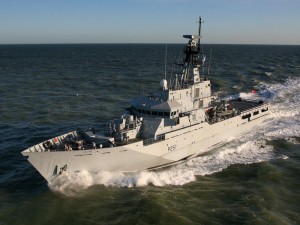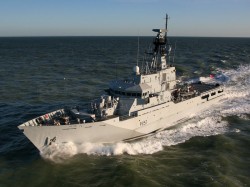 The Offshore Patrol Vessel (OPV) is a contemporary ship category not easily understood; it is mostly lost in the larger debate to distinguish similar vessel types such as frigates and corvettes. For our purposes, the OPV is a ship leaning towards enforcement or constabulary duties as opposed to being a dedicated combatant vessel, with a minimal weapons fit necessary to fulfill it’s function.
The Offshore Patrol Vessel (OPV) is a contemporary ship category not easily understood; it is mostly lost in the larger debate to distinguish similar vessel types such as frigates and corvettes. For our purposes, the OPV is a ship leaning towards enforcement or constabulary duties as opposed to being a dedicated combatant vessel, with a minimal weapons fit necessary to fulfill it’s function.
What then to make of it’s functions in wartime operations? What kind of value can nations gain from OPVs in a conventional, non-nuclear shooting war? OPVs can deliver good value in such a crisis, even though they are not dedicated surface combatants. Much like any other application of platforms, the vessel’s capabilities must be matched up to the assigned mission.
These applications are more suitable for larger navies, where OPVs exist as a distinct ship type usually assigned to coast guard function, either as combatants or as law-enforcement/search-and-rescue assets. For smaller navies, the OPV might be considered a major combatant type equivalent to a guided missile destroyer or other capital fleet unit, thus relegating these missions to even smaller and lighter vessels such as patrol craft.
In general, use of OPVs frees up a navy’s dedicated surface combatants to conduct the tactical operations necessary to fulfill whatever strategic goals needing to be met. In addition, OPVs can supplement some of those combatant roles if properly equipped to do so.
Constabulary Duties and Coastal Patrol – under wartime conditions, the requirement to provide security for stretches of coastlines or critical areas is more valid than ever. Hostile Special Forces, Non-State Actors and a host of other threats can benefit from an unsecured shoreline. And as history points out, life doesn’t stop because of war. There will still be commercial and private traffic (albeit at reduced levels) requiring monitoring and law-enforcement/safety-at-sea activities. OPVs will excel at this function with their long endurance, excellent fuel-economy (thanks to the ubiquitous use of diesels) and if confronted by significant enemy forces, can call upon air support and shore batteries thanks to coastline proximity.
Search-and-Rescue (SAR) – as part of a conventional war, there will inevitably be fleet casualties. While immediate SAR upon conclusion of an engagement is both efficient and humanitarian, surviving fleet units may need to egress immediately in response to a current threat, or to transit elsewhere for another mission. OPVs with their excellent seakeeping, and equipped with small boats and rescue helicopters are perfectly suited to follow-up SAR missions.
Supplementary Naval Forces – some maritime nations have experimented with up-arming their coastal guard forces with front-line equivalent equipment – notably the US Coast Guard’s baseline of the Hamilton-class cutters during the Cold War to have Harpoon missiles, close-in defenses and the ability to operate anti-sub helicopters. While modern OPVs have less deck and internal volume margin to become a true multi-role combatant; it’s not a far stretch to equip them with basic Anti-Surface Missiles, defensive Anti-Air mounts, and potentially towed array sonar. Their speed-of-advance would not make them suitable assets for front-line strikes, but OPVs could supplement fleet units by taking on secondary but vital missions that could free up a guided missile frigate or corvette – for example, providing close escort for a secondary supply line convoy or troop transports. Other creative ways would be to use OPVs as pickets – with a decent sonar suite, the ships could “trawl” across likely areas of enemy sub activity, passing back contact information to Command-and-Control for possible investigation. Conversely, many OPVs have a helicopter pad and some ability to carry “mission packages” such as relief equipment. Instead of humanitarian supplies, place an ELINT module aboard and load up on aerial drones to gather ISR and expand a fleet’s MDA.
It is important to keep in mind that such investments, including any necessary upgrades to bring OPVs to fleet-unit status, is extremely capital-intensive. However, in a wartime setting, it is assumed that cost is secondary to achieving whatever military and political goals required to end the conflict on favorable terms. Using OPVs in such roles will also require some proof-of-concept during peacetime, where there is opportunity to experiment and discover what does work in the field.
Fleet commanders should remain aware of the limitations of this concept. For starters, OPVs are not fast enough, nor are they capable of sufficient self-defense such that they can be committed to a heavily contested battlespace. Skills such as anti-sub warfare are extremely perishable. Specialist detachments will need to be embarked to supplement regular crews depending upon mission and equipment assigned. Integrating OPV forces into annual fleet training exercises is a good step to ensure operational readiness. Where possible, OPVs will do best in missions that are in close proximity to friendly forces. Despite all these limitations, the value proposition to utilize OPVs in conventional war is compelling, and should be considered seriously should force structure and budget allow.
Juramentado is the pseudonym for Armando J. Heredia, a civilian observer of naval affairs. He is an IT Risk and Information Security practitioner, with a background in the defense and financial services industries. The views and opinions expressed in this article are those of the author, and do not necessarily represent the views of, and should not be attributed to, any particular nation’s government or related agency.


Excellent article on a subject I’ve been trying to get across to the US Navy and most other world navies especially the navies of emerging countries who don’t have big budgets but do have big maritime crime problems.
We’ve taken the OPV to a new level by designing them on a high speed catamaran hull platform with a host of other innovative performance enhancing features. Where these vessels excel is that we build them in production molds using carbon fiber. Building them in productions moulds takes a matter of weeks to complete and this saving of man hours bring the price down to where they are competitive against metal OPV’s that take months of man hours to hand weld.
Carbon fiber excels as it is five times stronger than steel and less than half the weight of aluminium. The light weight is key to its success as it allows us to use smaller engines that cost less, weighs less and uses less fuel which allows them to outperform all metal OPV’s by cruising at 35 to 40 knots using 75% less fuel than steel OPV’s.
Our present production models come in four sizes 65’ & 85’ x 30’ and 105’ & 115’ x 35’ with larger custom sizes available. Armament options include two 50 caliber MG and/or two Bushmaster M242 other options are available.
Captain Graham Pfister
Calgary Alberta Canada
http://www.trawlercatmarine.com
Excellent article I would point out that OPVs should be larger because in my mind they can be better logistics support ships. Many designs are based on commerical OSV/OPV/OSCV ship types providing more capacity. And larger OPV could be better aircraft platforms as well as having space and power for larger sensor systems.
The cost to convert or upgrade an existing OPC design is FAR LESS than building any new construction warship or cutter.
I do NOT see speed as a rqmt of OPVs but rather endurance is key metric. Using a size formula to fit this new type in-between corvette and frigate is probably NOT a good comparison because again they are intended for lower Phase order missions, complimenting rather than supplementing warships.
Depending on the nature of the mission and operations, OPVs can make outstanding platforms for off-board MCM systems, can provide a close inshore resuscitation facility for wounded, and can provide ‘lilly pad’ flight decks to extend the range and/or endurance of helicopters operating from other vessels (especially if the available landing platforms are LPDs without a full-length flight deck, limiting the number of aircraft they can launch). In some scenarios they could.also be used to insert SF teams (speed is not always necessary), and they could serve as outlying pickets to guard the main force against attack by small fast craft. Depending on their radar and depending also on the types of SAM available, they could even help thicken the air defences by embarking modular SAM launchers. .
The key is to understand them (and design and build them) as multipurpose platforms from the outset, with lots of deck space and spare internal volume. Building too small is in any event silly: It does not save a lot of money and greatly limits the ship even in its primary peacetime role once seas get up a little. What was the old RN saying, ‘steel is cheap and air is free’? As long as one does not want to push the speed envelope or has a specific issue with needing to enter very small ports, it makes sense to go bigger.